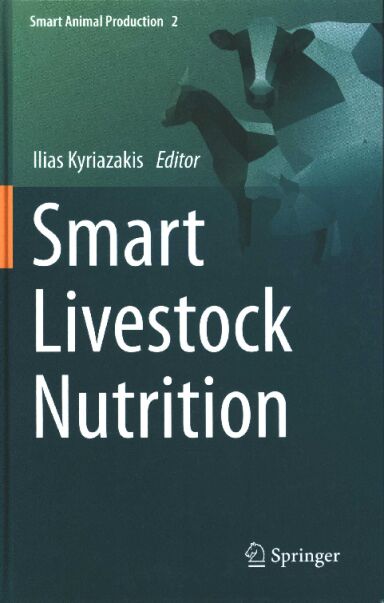书名:Smart livestock nutrition
摘要
There is an increased requirement to solve accurately the animal nutritionist’s problem of what will happen if a particular animal is fed in a particular way whilst kept in a specific environment at a specific point in time. The pressure arises from the need to develop more efficient livestock systems that reduce their impacts to the environment and enhance food security whilst at the same time provide improved animal welfare. It is associated with the fact that novel feedstuffs that meet the above criteria are entering the supply chains, whilst at the same time supply chains of traditional feedstuffs are being disrupted due to conflict, climate change and changes in human dietary habits, among other factors. The solution to the nutritionist’s problem is compounded by the fact that there is a change in the way we manage livestock, including the move towards large-scale units that rely less and less on human input in order to improve system efficiency and reduce labour shortages and costs.
Technological advances may enable the move towards such livestock systems whilst facilitating more accurate solutions to the way we feed and manage animals. Such technologies involve automation and capture of information that can be communicated to devices or networks that may allow decision-making in real or near-real time. One class of these technologies are the smart technologies, which are based on sensors operating on electronic technologies and are capable of capturing information about the various components of livestock systems. Their utility to the livestock sector is being enhanced by rapid advancements in the fields of computer and electronics, and their adaptation to provide tailor-made solutions.
It is within the context of this background that this book was developed. The principle of smart nutrition involves the utilisation of smart technologies in feeding and managing livestock. As an idea it is not a new one, but technological developments now enable the application of its principles to livestock systems where it was previously thought impossible. This is the case of feeding extensively kept ruminants in environments that may be challenging, due, for example, to their spatial heterogeneity. In addition, technological developments also enable data capture, transmissibility and storage, which are the usual bottlenecks in the application of such technologies on farm. It is, therefore, likely that we will be increasingly relying on such technologies in the future.
This book is essentially divided in two parts, although this distinction is not made explicitly. In the first part, we deal with advances in technologies that enhance or enable the capture of relevant information. At the same time advancements in fields of biology, such as in molecular agriculture, now enable the characterisation of animal and plant genomes to enable genotype selection in a faster and more targeted manner. The second part of the book deals with the applications of smart nutrition to a variety of livestock systems, ranging from intensively, indoor-managed systems for broilers and dairy cows to more extensively, outdoor-managed systems for beef cattle and sheep. Most of the book chapters have heuristic value as their authors were given the remit to consider how these systems may look in the future and how this can be achieved through the application of smart nutrition. The book concludes by considering the consequences of smart nutrition on the environmental impact of livestock systems, due to the current global focus on this issue. It is possible that the application of smart nutrition will confer other benefits in the future.
Like all multi-author endeavours, the book took a bit longer to be completed than desired. Because of this, several chapter authors expressed their concerns that their chapters may become outdated during the editing process, especially because new information in the field arises almost on daily basis. Given the heuristic value of the chapters I do not have similar concerns about outdateness. I am obviously grateful for the patience shown by my collaborators, but also for their rising to my challenge of writing chapters that were developing principles, so that will not be overtaken rapidly. I particularly enjoyed our collaboration and I hope that they also enjoyed it in return. I expect that some of the enjoyment of this interaction is reflected in the quality of the book and appreciated by its readership.
查看更多
目录
Putting Smart into Nutrition 1 [Ilias Kyriazakis] 1
2 Matching Feed Characteristics to Animal Requirements Through Plant Breeding [Leif Skøt, Christina Marley, David Lloyd, Alison Kingston-Smith, and Mike Humphreys] 17
3 Circular Feed Production and Consumption in the Context of Smart Animal Nutrition [Luciano Pinotti] 55
4 Assessment of the Nutritive Value of Individual Feeds and Diets by Novel Technologies [Knud Erik Bach Knudsen, Samantha Noel, and Henry Jørgensen] 71
5 Large-Scale Phenotyping and Genotyping: State of the Art and Emerging Challenges [Donagh P. Berry] 103
6 Mathematical and Statistical Approaches to the Challenge of Forecasting Animal Performance for the Purposes of Precision Livestock Feeding [Maciej M. Misiura, Joao A. N. Filipe, and Ilias Kyriazakis] 141
7 Smart Pig Nutrition in the Digital Era [Ludovic Brossard, Jaap van Milgen, Jean-Yves Dourmad, and Charlotte Gaillard] 169
8 Smart Poultry Nutrition [Martin J. Zuidhof, Mohammad Afrouziyeh, Sasha A. S. van der Klein, and Jihao You] 201
9 Advanced Technology in Aquaculture – Smart Feeding in Marine Fish Farms [Martin Føre, Morten Omholt Alver, Kevin Frank, and Jo Arve Alfredsen] 227
10 Smart Nutrition of Extensively Kept Ruminants [Luciano A. González, Janine Chang-Fung-Martel, and J. Augusto Imaz] 269
11 The Potential Contribution of Smart Animal Nutrition in Reducing the Environmental Impacts of Livestock Systems [Stephen George Mackenzie] 31
查看PDF
查看更多
馆藏单位
中国农科院农业信息研究所



